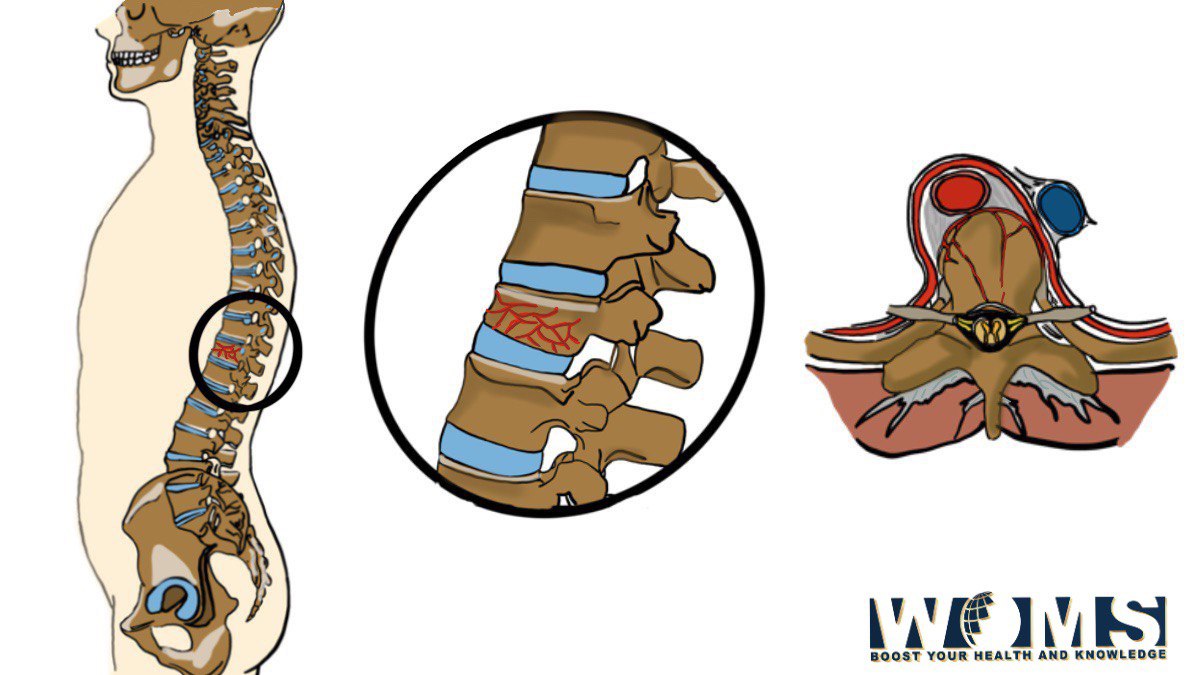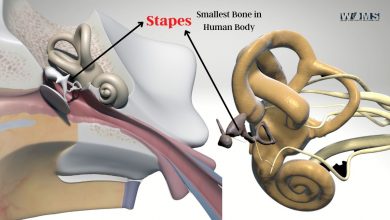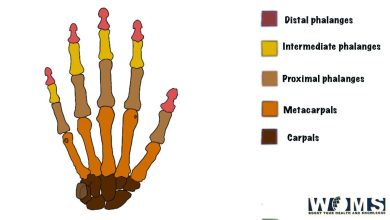Vertebral Fracture

A vertebral fracture is a break or breach in the continuity bone that occurs at one or more of the vertebrae. The most common fractures occur in the neck and lower back but can occur anywhere along the spine. Vertebral fractures may be caused by trauma such as motor vehicle accidents, falls from standing height, or direct blows to the spine. They also may result from osteoporosis or other diseases that weaken the vertebrae. Vertebral fractures often cause pain and disability. In some cases, however, the patient does not experience symptoms until months after the injury.
The diagnosis of vertebral fractures depends on x-ray examination. A radiologist will look for changes in the density and shape of vertebrae, indicating whether there has been a fracture. The doctor will order an x-ray study to confirm the diagnosis that a fracture is suspected.
Types of spinal fractures are
1. Compression fractures
This type of fracture involves damage to the vertebrae’s internal structure because it is compressed between two bony structures. This compression causes the vertebrae to lose their normal shape and density. Compression fractures usually occur when the body experiences a sudden force that compresses the spine. For example, this fracture is sometimes seen in people who have fallen off a ladder or motorcycle. It can also happen with severe injuries during sports activities.
2. Burst fractures
These types of fractures involve cracks within the vertebrae that form when a sudden blow or impact damages the vertebrae. These fractures are similar to compression fractures, except that the crack forms inside the vertebrae rather than outside. When these fractures occur in the cervical spine, they are called “bursting” fractures.
3. Transverse process fractures
Transverse process fractures occur when the transverse processes of the vertebrae are broken. The transverse processes are small projections on each side of the vertebrae that connect the upper part of the vertebrae to the spinous process. These are important parts of the vertebrae because they help stabilize the spine and protect nerves. Sometimes, transverse process fractures are accompanied by burst fractures.
4. Lateral mass fractures
Lateral mass fractures occur when the lateral masses of the vertebrae snap inward. The lateral masses are large portions of bone that extend outward from the sides of the vertebrae and attach to the ribs. These fractures are very rare and only occur when the vertebrae bend laterally.
5. Posterior element fractures:
Posterior element fractures occur when the posterior elements of the vertebrae break. These large triangular pieces of bone run down the backsides of the vertebrae near the top of the spinal canal. These fractures are uncommon.
Symptoms of a Vertebral Fracture
A vertebral fracture may produce no symptoms or may cause mild pain. However, if the fracture extends into the spinal canal, it may cause pressure on the spinal cord or nerve roots. Symptoms include:
- Pain in the neck, shoulders, arms, legs, or abdomen;
- Numbness or weakness in the affected areas;
- Difficulty moving the fingers, toes, or limbs;
- Loss of bladder control;
- Severe backache;
- Back stiffness;
- Sudden weight loss;

Causes of a Vertebral Fracture
The most common cause of a vertebral fracture is osteoporosis. Osteoporosis is a condition that weakens bones so much that they become brittle and prone to breaking. In addition, certain medications such as steroids and anticonvulsants can weaken bones. Other factors that contribute to a vertebral fracture include:
- Trauma: Fractures can be caused by trauma such as falls, motor vehicle accidents, or blows to the head.
- Rheumatoid arthritis: People with rheumatoid arthritis often develop bone spurs around joints. Spurring can lead to joint deformities and weakened bones.
- Cancer treatment: Chemotherapy and radiation treatments for cancer can destroy bone cells.
Diagnosing a Vertebral Fracture
Diagnosing a vertebral fracture requires x-rays. A physician will examine your x-ray films and determine whether you have fractures. They will ask about your medical history and perform a physical examination if you have a fracture. Your doctor may also order other tests to rule out other causes of your symptoms.
Testing for vertebral fracture
Your doctor may use one or more of these tests to diagnose a vertebral fracture:
1. Bone density test
Bone density testing measures how dense your bones are. It helps doctors predict which patients are at risk for developing osteoporosis.
2. Magnetic resonance imaging (MRI)
Magnetic resonance imaging (MRI) uses powerful magnets and radio waves to create detailed images of organs and structures inside the body. An MRI scan can help detect abnormalities in the spine.
3. Dual-energy x-ray absorptiometry (DEXA)
This test uses two types of x-rays to measure bone mineral density. DEXA scans provide information about calcium and minerals in your bones. This test monitors people who take drugs that affect bone metabolism.
4. X-ray
A plain film x-ray shows the outline of each vertebra. The x-ray allows physicians to see if the vertebra has an abnormal shape or size.
5. Computed tomography (CT) scan
A CT scan produces cross-sectional images of the body using special equipment and computer technology. CT scans show details of the bony structure of the spine. They can also reveal tumors, blood clots, and other problems.
Treatment Options for Vertebral Fractures
Treatment options depend on the type of fracture and severity of symptoms. For example, people who experience mild pain and limited movement may not need surgery. On the other hand, people who suffer severe pain or cannot move their bodies at all should consider surgical intervention. Surgery involves removing damaged bone fragments and inserting metal rods and screws to hold the vertebrae together. This helps prevent further damage to the spine.
Preventing Vertebral Fractures
There are many ways to help prevent vertebral fractures. You can take these steps:
- Increase calcium intake—Calcium is an important component of strong bones. Calcium supplements and fortified foods are good sources of calcium.
- Exercise regularly—Exercise strengthens muscles and improves balance. It also increases bone density and reduces the risk of falling.
- Maintain healthy body weight—Being overweight puts extra strain on your bones. Losing weight through diet and exercise helps keep bones strong.
- Avoid smoking—Smoking decreases bone mineral density.
- Take prescribed medication—Some medicines can increase the risk of developing osteoporosis. Talk to your doctor before taking any new prescription drugs.
Aging & Health
Older adults face unique health challenges. Learn what it takes to stay well into older adulthood.
Many people think of aging as a decline in function, but another side to it is the ability to adapt to change and remain active and engaged in life. The challenge is maintaining this sense of vitality and purpose throughout one’s lifetime.
The key to staying healthy and independent is to avoid illness and injury. To do this, it’s important to know how to recognize signs of disease and injury and when to seek care from a healthcare provider.
Preventive Measures for Healthy Aging
As we age, our bodies change. We lose muscle mass and strength, which makes us more prone to falls. Bones become brittle and break easily. Our senses deteriorate, making it harder to hear, see, smell, taste, or feel things. These changes make it difficult to get around safely. They also affect our mood and mental abilities.
As we grow older, we must pay attention to our overall health. We should eat right and get enough sleep and rest. We should also try to reduce stress levels by exercising, getting plenty of fresh air, and having social interactions with others. All of these activities contribute to maintaining a healthy lifestyle.
When & How to Seek Medical Care
It’s important to have regular checkups so that doctors can monitor your health and detect problems early. Your primary care physician can recommend appropriate tests and treatments based on your medical history. If you think you might have a problem, don’t hesitate to ask questions about your condition and treatment options.
Contact your doctor immediately if you notice any changes in your physical appearance or bodily functions, such as difficulty walking, dizziness, shortness of breath, or weakness.
Conclusion
Vertebral (spinal) fracture is quite common among older adults. It is caused by osteoporosis, which results in the weakening of the bones. As a result, the body loses its ability to support the upper body’s weight. The most vulnerable part of the body is the spine. The spine is made up of many small bones called vertebrae. Each vertebra has a strong outer shell called cortical bone. Inside this shell lies a softer inner core called cancellous bone.
Frequently Asked Question On Vertebral Fractures
What is a spinal compression fracture?
A vertebral compression fracture occurs when a weakened vertebra breaks under pressure. This type of fracture usually affects women who have been diagnosed with osteoporosis. Osteoporosis weakens the spine’s bony structure and causes the bones to break easily.
When does a person first develop a vertebral fracture?
Most patients with vertebral fractures experience symptoms within three months after the initial injury. In some cases, however, symptoms may not appear until several years later.
Is there a cure for a vertebral fracture? Can they heal naturally?
No. A vertebral fracture cannot heal without surgery.
Will I need an operation if my back hurts?
Yes. Surgery is often required to stabilize the fractured bone and relieve pain.
What are the risks associated with a vertebral fracture? Are there complications?
Complications include loss of height, nerve damage, infection, and blood clots.




